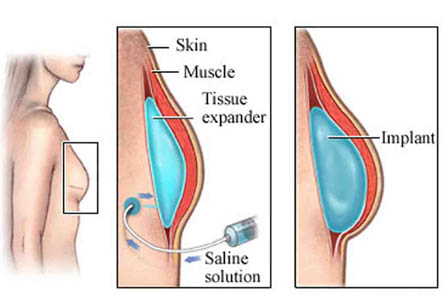Breast Reconstruction
Introduction
Breast cancer often means removal of large parts of the breast. Breast reconstruction may be done to reconstruct or recreate the breast after surgery.
Reconstruction may be of various types. The breast may be re-made using a breast implant or with a tissue flap of the patient. There may be a combination of the two. A tissue flap is a section of the patient’s own skin, fat, and in some cases muscle that may come from her abdomen, back or other area. An implant may be a saline-filled implant that is a silicone bag filled with salt water (sterile saline) or silicone gel filled implants. They are not used as often as they were in the past because of concerns that silicone leakage.
Surgical Procedure
The reconstruction surgery may be done at the same time as breast removal surgery or mastectomy. Here the oncosurgeon removes the breast tissue and the plastic surgeon places a breast implant. The implant is placed in the space created on removal of the breast. The other is a two stage reconstruction. Here the first surgery is mastectomy and a second surgery after a few months is the reconstruction. An implanted tissue expander, which is like a balloon, is put under the skin and chest muscle. Through a tiny valve under the skin, the surgeon injects a salt-water solution at regular intervals to fill the expander over time (about 4 to 6 months). Once the skin over the breast is stretched adequately a second surgery is done to remove the expander and put in the permanent implant.
We have all the information you need about public and private Cosmetic / Plastic clinics that provide Breast Reconstruction in Iran, Islamic Republic Of

Nipple and areola reconstructions are optional and usually the final phase of breast reconstruction.
Breast implants often do not last a lifetime. These may need replacement and the implants used for breast reconstruction have to be removed, modified, or replaced after around a decade of use. A breast implant also makes routine mammograms to screen for breast cancer on the remaining breast or coming back of the cancer difficult. Implants also affect ability to breast feed, either by reducing the amount of milk or stopping the body from making milk.
For tissue flaps bits from abdomen, thighs, back or buttocks are used. The 2 most common types of tissue flap procedures are the TRAM flap (or transverse rectus abdominis muscle flap), which uses tissue from the lower abdomen area, and the latissimus dorsi flap, which uses tissue from the upper back.
These carry the disadvantage of leaving scars at the site of surgery and the breast. There is also a risk of abdominal hernias and muscle damage or weakness. Shape of the reconstructed breast may not be uniform with tissue flaps. Diabetics, smokers, those with connective tissue or vascular disease have problems of blood supply and may not be candidates for flaps. These however, last a lifetime and usually need no replacement.
Nipple and the areola may also be reconstructed after mastectomy. Nipple and areola reconstructions are optional and usually the final phase of breast reconstruction. These need separate surgery. It can be done as an outpatient after drugs are used to make the area numb (under local anesthesia) usually 3 to 4 months after initial surgery.
Tissue used to rebuild the nipple and areola also is taken from elsewhere in the body, such as from the opposite nipple, ear, eyelid, groin, upper inner thigh, or buttocks. A tattoo may be used to match the color of the nipple of the other breast and for the areola.